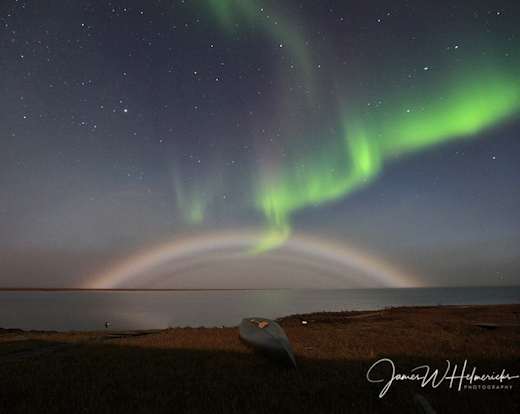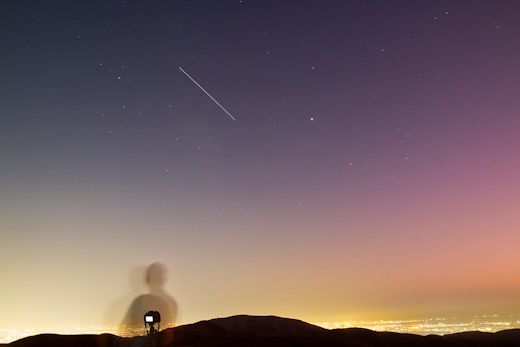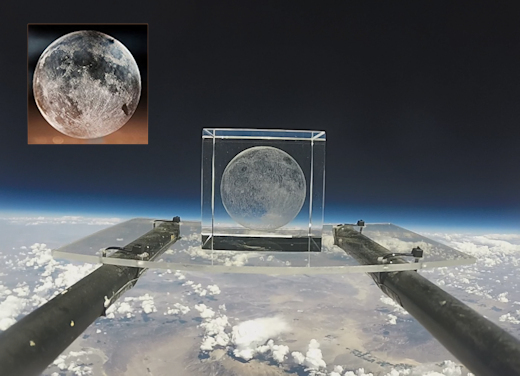Solar minimum is here - but even now strangely beautiful auroras are dancing around the poles. Deep inside the Arctic Circle, the expert guides of Aurora Holidays in Utsjoki, Finland, can help you chase them. Book now! | | |
CAN YOU SEE INTERSTELLAR COMET BORISOV? Answer: Probably not. Interstellar Comet Borisov (C/2019 Q4) is currently very dim (magnitude +17) and unless something truly bizarre happens, it's going to stay that way. At closest approach in December, Comet Borisov will still be 2 AU (300 million km) away from the sun. Feeble solar heating will increase the comet's brightness only a little to magnitude +15--that is, 4000 times too faint to see with the naked eye. Now for the good news: Comet Borisov is truly bizarre, so the unexpected could happen. [photo gallery]
NORTHERN LIGHTS AND A LUNAR FOGBOW: The end of summer is a good time to be in Aslaska. Specifically, on the foggy banks of the Coleville River Delta. Last night, photographer James Helmericks was there, and this is what he saw:

"Bright moonlight created a fogbow as Northern Lights rippled across the sky," says Helmericks. "At one point, the fogbow brightened so much it created a reflection in the river."
Fogbows are close cousins of rainbows, and they are formed in essentially the same way: light bounces in and out of water droplets. The difference is droplet size. Large raindrops make rainbows. Smaller droplets of water make fogbows. Small droplets don't separate the colors of sunlight as widely as large raindrops do. In a fogbow, therefore, the colors are smeared together, producing a ghostly-white arc.
The auroras were an autumnal bonus. There was no geomagnetic storm in progress, however, no storm was required. At this time of year, during nights around the equinox, cracks open in Earth's magnetic field. Solar wind pours in to fuel Arctic lights. Aurora alerts: SMS Text.
Realtime Aurora Photo Gallery
Free: Spaceweather.com Newsletter
SPACE STATION FLIES THROUGH A RAIKOKE SUNSET: On June 22nd, astronauts on board the International Space Station photographed a volcanic eruption so large, it could be seen from Earth orbit. The Raikoke volcano in the Kirul Islands sent a plume of gas all the way up into the stratosphere. Three months later, a photographer from a small village in Iran saw the ISS fly through a purple "Raikoke sunset."

"At the end of the day on Sept. 19th, I was waiting for the space station to appear when the sky turned purple," says Ali Norouzi Varankeshi of Baraghan, Iran. "It was a volcanic sunset, and the ISS flew right through it. I photographed the flyby from a hillside overlooking the city lights of nearby Karaj."
Months after the astronauts first noticed Raikoke, its emissions are still lingering in the upper atmosphere. Fine volcanic aerosols in the stratosphere scatter blue light which, when mixed with ordinary sunset red, produces a purple hue. Last month, the Ulawun volcano in New Guinea also sent sulfurous gases into the stratosphere, enhancing the effect.
People around the world are seeing these purple sunsets--not every night, because the volcanic gas is patchy, but often. The purple color is usually preceded by a yellow arch hugging the horizon. As the sun sets, violet beams emerge from the yellow, overlapping to fill the western sky with a soft purple glow.
Realtime Volcanic Sunset Photo Gallery
Free: Spaceweather.com Newsletter
3D LASER-ETCHED MOON: On August 16, 2018, the students of Earth to Sky Calculus launched a cosmic ray balloon to the stratosphere. This unique laser-etched Moon cube went along for the ride, ascending to an altitude of 101,140 feet:

You can have it for $119.95. The students are selling these cubes as a fund-raiser for their cosmic ray ballooning program. It's an authentic representation of the Moon, with all of the craters, mountains and lava plains accurately portrayed.
Each Moon-cube comes with a unique gift card showing the item floating at the top of Earth's atmosphere. The interior of the card tells the story of the flight and confirms that this gift has been to the edge of space and back again.
Far Out Gifts: Earth to Sky Store
All sales support hands-on STEM education
Realtime Space Weather Photo Gallery
Free: Spaceweather.com Newsletter
Every night, a network of
NASA all-sky cameras scans the skies above the United States for meteoritic fireballs. Automated software maintained by NASA's Meteoroid Environment Office calculates their orbits, velocity, penetration depth in Earth's atmosphere and many other characteristics. Daily results are presented here on Spaceweather.com.
On Sep. 20, 2019, the network reported 19 fireballs.
(19 sporadics)

In this diagram of the inner solar system, all of the fireball orbits intersect at a single point--Earth. The orbits are color-coded by velocity, from slow (red) to fast (blue). [Larger image] [movies]
Potentially Hazardous Asteroids (
PHAs) are space rocks larger than approximately 100m that can come closer to Earth than 0.05 AU. None of the known PHAs is on a collision course with our planet, although astronomers are finding
new ones all the time.
On September 20, 2019 there were 2018 potentially hazardous asteroids.
 |
Recent & Upcoming Earth-asteroid encounters: | Asteroid | Date(UT) | Miss Distance | Velocity (km/s) | Diameter (m) |
| 2019 JF1 | 2019-Sep-16 | 11.2 LD | 4.3 | 62 |
| 2019 SD | 2019-Sep-16 | 5.8 LD | 10.2 | 29 |
| 2018 FU1 | 2019-Sep-16 | 18.4 LD | 4.7 | 16 |
| 2019 SJ | 2019-Sep-16 | 0.6 LD | 8.7 | 11 |
| 2019 RC | 2019-Sep-16 | 17.4 LD | 15.1 | 157 |
| 2019 SN | 2019-Sep-17 | 19.2 LD | 7.4 | 30 |
| 2019 SC | 2019-Sep-19 | 1.4 LD | 13.5 | 13 |
| 2019 RP2 | 2019-Sep-20 | 8.5 LD | 1.6 | 6 |
| 2019 ST | 2019-Sep-20 | 5.5 LD | 12.9 | 46 |
| 2017 SL16 | 2019-Sep-21 | 7.9 LD | 6.5 | 25 |
| 2017 SM21 | 2019-Sep-21 | 11.5 LD | 9.6 | 20 |
| 2019 RE2 | 2019-Sep-21 | 19.7 LD | 8.7 | 43 |
| 2019 RB3 | 2019-Sep-21 | 19 LD | 11.8 | 50 |
| 2019 SX | 2019-Sep-21 | 1.1 LD | 14.4 | 4 |
| 2019 QZ1 | 2019-Sep-22 | 12.5 LD | 8.2 | 77 |
| 523934 | 2019-Sep-24 | 10.9 LD | 22.3 | 257 |
| 2019 QY3 | 2019-Sep-26 | 13.9 LD | 8.4 | 40 |
| 2017 KP27 | 2019-Sep-26 | 4.2 LD | 4.7 | 25 |
| 2006 QV89 | 2019-Sep-27 | 18.1 LD | 4.1 | 31 |
| 2019 SP | 2019-Sep-30 | 6.7 LD | 14.8 | 46 |
| 2018 FK5 | 2019-Oct-01 | 13.3 LD | 10.5 | 8 |
| 2018 LG4 | 2019-Oct-02 | 13.8 LD | 8.1 | 12 |
| 2017 TJ4 | 2019-Oct-05 | 13.5 LD | 8.9 | 32 |
| 2019 RK | 2019-Oct-08 | 16.7 LD | 3.1 | 31 |
| 162082 | 2019-Oct-25 | 16.2 LD | 11.2 | 589 |
| 2017 TG5 | 2019-Oct-25 | 14.4 LD | 11.9 | 34 |
| 2015 JD1 | 2019-Nov-03 | 12.9 LD | 11.9 | 269 |
| 2010 JG | 2019-Nov-12 | 19.6 LD | 14.9 | 235 |
Notes: LD means "Lunar Distance." 1 LD = 384,401 km, the distance between Earth and the Moon. 1 LD also equals 0.00256 AU. MAG is the visual magnitude of the asteroid on the date of closest approach. | | Cosmic Rays in the Atmosphere |
SOMETHING NEW! We have developed a new predictive model of aviation radiation. It's called E-RAD--short for Empirical RADiation model. We are constantly flying radiation sensors onboard airplanes over the US and and around the world, so far collecting more than 22,000 gps-tagged radiation measurements. Using this unique dataset, we can predict the dosage on any flight over the USA with an error no worse than 15%.
E-RAD lets us do something new: Every day we monitor approximately 1400 flights criss-crossing the 10 busiest routes in the continental USA. Typically, this includes more than 80,000 passengers per day. E-RAD calculates the radiation exposure for every single flight.
The Hot Flights Table is a daily summary of these calculations. It shows the 5 charter flights with the highest dose rates; the 5 commercial flights with the highest dose rates; 5 commercial flights with near-average dose rates; and the 5 commercial flights with the lowest dose rates. Passengers typically experience dose rates that are 20 to 70 times higher than natural radiation at sea level.
To measure radiation on airplanes, we use the same sensors we fly to the stratosphere onboard Earth to Sky Calculus cosmic ray balloons: neutron bubble chambers and X-ray/gamma-ray Geiger tubes sensitive to energies between 10 keV and 20 MeV. These energies span the range of medical X-ray machines and airport security scanners.
Column definitions: (1) The flight number; (2) The maximum dose rate during the flight, expressed in units of natural radiation at sea level; (3) The maximum altitude of the plane in feet above sea level; (4) Departure city; (5) Arrival city; (6) Duration of the flight.
SPACE WEATHER BALLOON DATA: Approximately once a week, Spaceweather.com and the students of Earth to Sky Calculus fly space weather balloons to the stratosphere over California. These balloons are equipped with radiation sensors that detect cosmic rays, a surprisingly "down to Earth" form of space weather. Cosmic rays can seed clouds, trigger lightning, and penetrate commercial airplanes. Furthermore, there are studies ( #1, #2, #3, #4) linking cosmic rays with cardiac arrhythmias and sudden cardiac death in the general population. Our latest measurements show that cosmic rays are intensifying, with an increase of more than 18% since 2015:

The data points in the graph above correspond to the peak of the Reneger-Pfotzer maximum, which lies about 67,000 feet above central California. When cosmic rays crash into Earth's atmosphere, they produce a spray of secondary particles that is most intense at the entrance to the stratosphere. Physicists Eric Reneger and Georg Pfotzer discovered the maximum using balloons in the 1930s and it is what we are measuring today.
En route to the stratosphere, our sensors also pass through aviation altitudes:

In this plot, dose rates are expessed as multiples of sea level. For instance, we see that boarding a plane that flies at 25,000 feet exposes passengers to dose rates ~10x higher than sea level. At 40,000 feet, the multiplier is closer to 50x.
The radiation sensors onboard our helium balloons detect X-rays and gamma-rays in the energy range 10 keV to 20 MeV. These energies span the range of medical X-ray machines and airport security scanners.
Why are cosmic rays intensifying? The main reason is the sun. Solar storm clouds such as coronal mass ejections (CMEs) sweep aside cosmic rays when they pass by Earth. During Solar Maximum, CMEs are abundant and cosmic rays are held at bay. Now, however, the solar cycle is swinging toward Solar Minimum, allowing cosmic rays to return. Another reason could be the weakening of Earth's magnetic field, which helps protect us from deep-space radiation.
| | The official U.S. government space weather bureau |
| | The first place to look for information about sundogs, pillars, rainbows and related phenomena. |
| | Researchers call it a "Hubble for the sun." SDO is the most advanced solar observatory ever. |
| | 3D views of the sun from NASA's Solar and Terrestrial Relations Observatory |
| | Realtime and archival images of the Sun from SOHO. |
| | from the NOAA Space Environment Center |
| | fun to read, but should be taken with a grain of salt! Forecasts looking ahead more than a few days are often wrong. |
| | from the NOAA Space Environment Center |
| | the underlying science of space weather |
 | To find reviews of new online casino sites in the UK try The Casino DB where there are hundreds of online casino reviews complete with bonuses and ratings. Looking for a new online casino? Try Casimpo the new site dedicated to making online casino simple and easy for all. |
| | These links help Spaceweather.com stay online. Thank you to our supporters! |
| | | | | | |

